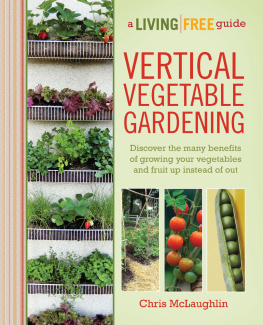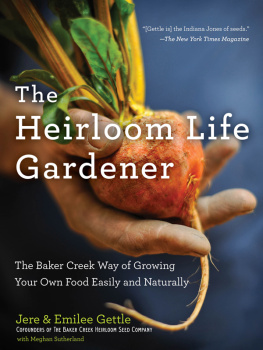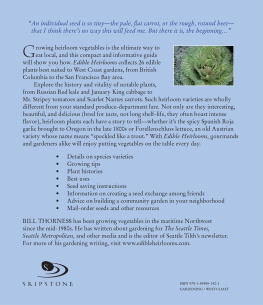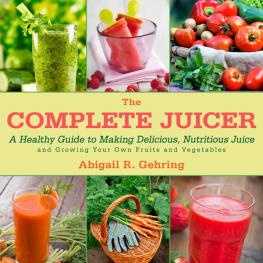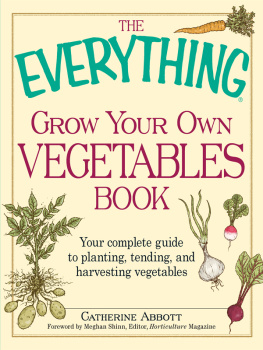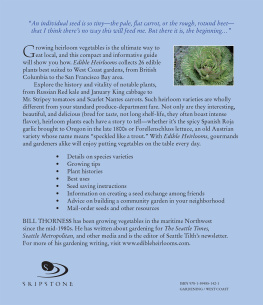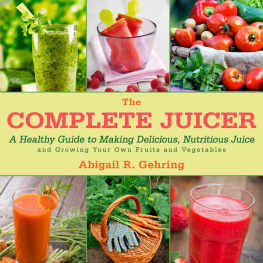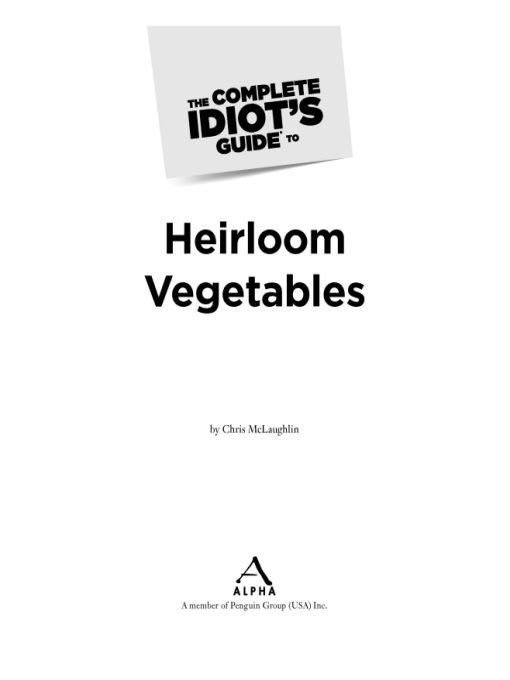Table of Contents
For my youngest, Bella, who gives up many, many hours with her mom when books are being written.
Introduction
Ive been growing vegetables since the eighth grade. I enjoyed it mostly because it amazed me to watch plants start off as a seed and then one day actually produce food for the table. At that time, my small garden was limited to tomatoes, strawberries, and an herb or two. Still, I was pleased that I could grow anything at all.
Over the years, my love for gardening turned into passion, and I managed to add to my plant repertoire. I was well past that ah-ha! moment that I first felt when Id made the plant/food connection at 14. At one point, my husband and I lived in the California Sierra foothills and I became friends with Allure, who was smart in the ways of the world and especially gifted with plants.
She took me to her gardens and I saw my first purple fingerling potatoes. They looked gnarled and much darker and more colorful than a potato should have been, I thought. She cooked them, and we ate the little oddities. Buttery and full of flavor, they were wonderful, and I immediately added them to my next seasons seed list. She showed me other vegetable and flower varieties that Id never seen before.
I had no idea that I was being introduced to my first heirloom plants. This knowledgeable woman shared with me many seeds that shed collected from her own gardens and so I witnessed that universal generosity that true gardeners possess.
At the end of the season, Allure showed me how to collect the seeds from my plants so I could grow the same varieties the next year. I was smitten, and I had another ah-ha! moment. Until then I had always just purchased new seeds every year.
I had no idea that I couldnt have kept the seeds from the varieties I grew even if I had known the techniquesbecause Id been purchasing hybrid varieties. I fell in love with these special and unique heirloom plants, although I still hadnt learned that the group had a name.
Most people havent seen, much less eaten, purple potatoes, white carrots, or striped tomatoes. These are the varieties of our ancestors, and they grew them for good reason. Come see what makes heirlooms special and why they have earned their way into the hearts of so many gardeners.
Let me share with you hints for growing healthy and high-yielding crops and techniques for saving seeds from your own garden. In the Heirloom Vegetable Directory, meet the veggies and choose varieties that have laugh-out-loud names, rich heritages, amazing colors, and mouthwatering flavors.
How This Book Is Organized
The Complete Idiots Guide to Heirloom Vegetables is divided into three parts.
In Part 1, Our Vegetable Inheritance, I give the definitions of heirloom vegetables, and there are several. Ill discuss some excellent reasons to grow heirlooms, including their fantastic flavors and why they taste better than the bland stuff in the produce section of the supermarket. Ill get into heirloom plants incredible adaptability to specific climates. Ill also talk about their far-out names and the interesting stories behind them.
Ill explain why growing vegetables gives you some control over what you and your family eat, as well as explore how they connect us to our past. Youll learn a little bit about genetics and the important role genetic diversity plays in our future.
Youll learn how your vegetables become pollinated and the importance of who pollinates them. Ill explain the difference between open-pollination and hybridization. Ill get into what monoculture is and why commercial companies use it. If youve ever been confused by the term GMO and what that really is about, Ill explain it in this part of the book. Ill also talk about what makes seed banks important and why you just may want a seed bank of your own.
This part also goes over how to choose the right heritage varieties for your garden. We look at how much space you have, who will be helping you, your growing zone, and what you plan on doing with the harvest. I also have some excellent gardening practices to share with you to help your veggies flourish.
Part 2, The Birds, the Bees, and Saving Seeds, is dedicated to one of the most wonderful aspects of heirlooms: the fact that you can save seed that breeds true! Ill talk about annuals, perennials, and biennials and why it makes a difference if youd like to collect and save heirloom seeds.
Ill get into what pure pollination is and techniques for preventing undesirable cross-pollination. Ill explain how to use caging or bagging techniques in case distance isnt available. Youll also learn how to hand-pollinate plants to ensure pure pollination or to make sure your plants are pollinated at all.
This part also discusses collecting, cleaning, drying, and storing seed to save for next years crops.
Part 3, The Heirloom Vegetable Directory, is a collection of hundreds of heirloom vegetables for you to peruse to see which vegetable varieties appeal to you and yours. Youre going to be amazed at the variety, but its only a sample of the heirlooms available to the home gardener.
Last, I have a glossary of common heirloom and vegetable terms, as well as a resources section listing many different heirloom seed companies that are sure to carry any variety that strikes your fancy. Feel free to contact the companies with any questions you may have. These folks are passionate about what they do, and theyre more than willing to give guidance.
If youd like to see color images of the varieties listed in the directory, I have them in an online collection at www.cigheirloomvegetables.com. If you have any images youd like to share for the site, feel free to e-mail me at the website.
More Cool Stuff
Just to keep things fun and interesting, Ive added some sidebars with hints and cautions to make your heirloom growing experience easier and more rewarding.
HERITAGE HINT
These boxes will give you some extra ideas and tips for growing heirloom vegetables in your own garden.
WEED!
Here youll find warnings and things to consider about growing heritage veggies.
DEFINITION
These sidebars provide definitions and details about specific heirloom and vegetable terms and techniques.
Acknowledgments
Once again I find myself indebted to my incredibly patient family and friends who are certain by now that Ive lost my mind. I want to thank my uber-cool dream editor, Tom Stevens, for picking up the phone every time I call.
Penguin Group and Alpha Books, whose educational Complete Idiots Guide series are serious fun to write. My agent, Marilyn Allen, who (like Tom) always picks up the phone. My wonderful editors on this book, Megan Douglass and Kayla Dugger. A huge thank you to Mayo Underwood for being my professional eye and an astounding heirloom pioneer in her own right.


